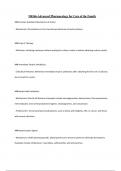NR566-Advanced Pharmacology for Care of the Family
### β-lactam Antibiotic Mechanism of Action
- Mechanism: All antibiotics in this class disrupt bacterial cell wall synthesis.
### Empiric Therapy
- Definition: Initiating treatment without waiting for culture results or before obtaining culture results.
### Immediate Empiric Antibiotics
- Critically Ill Patients: Administer immediate empiric antibiotics after obtaining the first set of cultures;
do not wait for results.
### Bactericidal Antibiotics
- Mechanism: Directly kill bacteria. Examples include aminoglycosides, beta-lactams, fluoroquinolones,
metronidazole, most antimycobacterial agents, streptogramins, and vancomycin.
- Preferred for: Immunocompromised patients, such as those with diabetes, HIV, or cancer, and those
with severe infections.
### Bacteriostatic Agents
- Mechanism: Inhibit bacterial growth, allowing the host's immune system to eliminate the bacteria.
Examples include clindamycin, macrolides, sulfonamides, and tetracyclines.
,### β-lactam Antibiotics
- Examples: Penicillins, cephalosporins, carbapenems, monobactams.
### Penicillins Mechanism of Action
- Mechanism: Weaken bacterial cell wall by:
1. Inhibiting transpeptidases.
2. Activating autolysins (disinhibition).
### Penicillin Binding Proteins (PBPs)
- Definition: Transpeptidases, autolysins, and other bacterial enzymes collectively referred to as PBPs,
which penicillins must bind to for antibacterial effects.
### Gram-positive Bacteria
- Structure: Composed of two layers—the cytoplasmic membrane and a thick cell wall. Penicillins are
generally very effective against these bacteria.
### Gram-negative Bacteria
,- Structure: Composed of three layers—the cytoplasmic membrane, a thin cell wall, and an additional
outer membrane. Only certain penicillins, such as ampicillin, can cross and reach the PBPs.
### Four Major Groups of Penicillins
1. Narrow-spectrum penicillins that are penicillinase-sensitive.
2. Narrow-spectrum penicillins that are penicillinase-resistant (antistaphylococcal penicillins).
(3) broad-spectrum penicillins (aminopenicillins)
(4) extended-spectrum penicillins (antipseudomonal penicillins).
narrow-spectrum penicillins: Penicillinase sensitive penicillins ✅Penicillin G, Penicillin V
narrow-spectrum penicillinase sensitive susceptible pathogens ✅Streptococci, Neisseria, anaerobes
very narrow antimicrobial spectrum and are used only against penicillinase-producing strains of
staphylococci (S. aureus and S. epidermidis). ✅narrow-spectrum penicillins: penicillinase resistant
penicillins
narrow-spectrum penicillins: penicillinase resistant penicillins ✅Nafcillin, Oxacillin, Dicloxacillin
, narrow-spectrum- penicillinase resistant susceptible pathogens ✅S. Aureus, S. Epidermidis
Drugs of choice for most staphylococcal infections ✅penicillinase-resistant penicillins (Nafcillin,
Oxacillin, Dicloxacillin)
Broad spectrum Penicillin: Aminopenicillins ✅Ampicillin, Amoxicillin
Broad spectrum Aminopenicillin susceptible pathogens ✅Haemophilus influenzae, Escherichia coli,
Proteus mirabilis, enterococci, Neisseria gonorrhoeae
Extended spectrum penicillins (antipseudomonal penicillin) ✅Piperacillin
Has the same antimicrobial spectrum as penicillin G, plus increased activity against certain gram-
negative bacilli, including Haemophilus influenzae, Escherichia coli, and Salmonella and Shigella ✅Broad
spectrum Penicillin: Aminopenicillins
First line for acute otitis media and sinusitis ✅Amoxicillin




